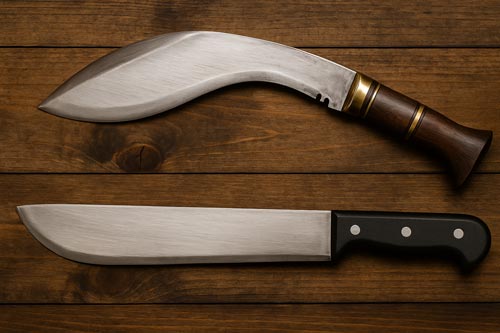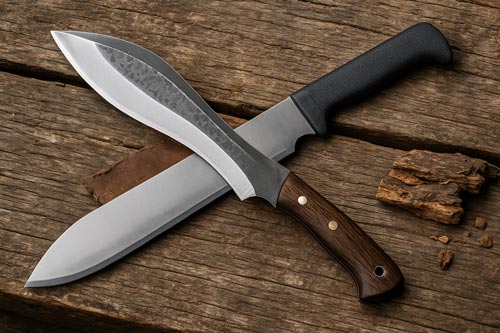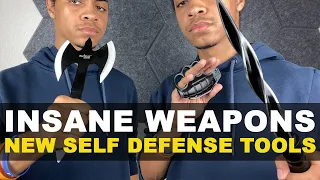Kukri vs Machete: What's the Real Difference?
November 11th, 2025

Most people lump the kukri and the machete into the same category, but anyone who's actually swung them knows they couldn't feel more different. One was born on the battlefields of Nepal, designed to cut through enemies and brush alike. The other became the workhorse of farmers, explorers, and survivalists across the tropics. Knowing how these two blades differ isn't just trivia; it determines which one belongs in your hand the next time you head outdoors.
Shape and Design

The most obvious difference between a kukri and a machete is in the shape of the blade. A kukri has a forward-curving design that concentrates weight near the tip, giving it an incredible chopping force despite its compact size. The inward curve also makes it effective for controlled slicing and carving. In contrast, a machete usually has a long, straight or slightly curved blade that spreads weight more evenly. This makes it ideal for clearing brush, cutting vegetation, and performing long, sweeping motions. The kukri feels like a hybrid between a knife and a hatchet, while the machete functions more like a short sword built for endurance and reach.
Origin and Purpose

The kukri and the machete may share similar chopping abilities, but they come from completely different worlds. The kukri's roots trace back hundreds of years to Nepal, where it became the signature weapon of the Gurkhas. These legendary soldiers carried the kukri as both a utility tool and a combat weapon, relying on its distinctive curve for devastating strikes. Its heavy forward balance made it powerful enough to chop wood or bone, yet precise enough for close-quarters defense. Over time, the kukri evolved into a symbol of courage and craftsmanship in Nepalese culture, often passed down through generations.
The machete, on the other hand, developed out of necessity in tropical regions across Central and South America, Africa, and Asia. Instead of being designed for battle, it was built for survival and labor. Farmers and explorers used it to clear brush, harvest crops, and blaze trails through dense jungle. Because of its reach and straight edge, it became indispensable for both agriculture and exploration. Only later did the machete earn a reputation as a defensive tool, when people realized that a long, heavy blade could easily double as a weapon if needed.
Weight and Handling

Once you pick up each blade, the difference in balance and feel becomes obvious. A kukri has a pronounced forward weight that gives it surprising chopping power for its size. When you swing it, the curved edge naturally bites into the target with less effort, allowing you to cut through wood or bone efficiently. The heavy belly of the blade does most of the work, while the inward curve provides excellent control for finer tasks like skinning or carving. This unique geometry makes the kukri a favorite among survivalists who want a tool that can double as both a hatchet and a knife.
A machete, on the other hand, is lighter and more evenly balanced. Instead of relying on brute force, it's designed for endurance and wide, sweeping motions. That makes it ideal for hacking through tall grass, clearing branches, or cutting sugarcane without tiring your arm. Its longer blade also gives you more reach, which is why it's often used in agricultural or jungle environments. Where the kukri dominates in concentrated power, the machete wins in speed and stamina.
Practical Uses in the Real World

When it comes to everyday function, the kukri and machete fill slightly different niches. The kukri excels as a multipurpose survival blade. Its curved belly makes it perfect for chopping wood, cutting rope, or even butchering meat in the field. The angle of the blade allows you to carve or dig without awkward wrist movement, which is why it's often found in the gear of campers, preppers, and bushcraft enthusiasts. In a pinch, the kukri also performs well for defense since its weight-forward design delivers heavy, controlled blows that few other blades can match.
The machete is more of a workhorse than a weapon. It's designed for long days of use, handling repetitive cutting without fatigue. Farmers use it for harvesting sugarcane and clearing brush, while adventurers rely on it to create trails and shelters. It's also an essential tool in many parts of the world where thick vegetation dominates the landscape. While the machete doesn't have the same intimidating close-quarters utility as the kukri, its versatility in outdoor and agricultural work makes it an irreplaceable tool for anyone spending time off the beaten path.
Materials and Construction

Both the kukri and the machete are built to take abuse, but their construction reflects the jobs they were made for. Traditional kukris are often hand-forged from high-carbon steel, giving them incredible edge retention and strength. The thick spine and tapered point allow for powerful chopping while still maintaining balance. Many modern kukris keep the same forged look but use updated steels and full-tang construction for better durability. Their handles are usually made from hardwood, horn, or micarta, providing a comfortable grip for heavy-duty work. The kukri's craftsmanship is part of its identity, and each one feels unique, carrying the spirit of the blacksmith who made it.
Machetes, in contrast, are built for mass use and efficiency. Most are made from stainless or spring steel, which is more resistant to rust and easier to sharpen in the field. Their blades tend to be thinner and more flexible, making them ideal for repetitive motion and fast clearing tasks. Machete handles are typically molded from rubber or plastic to withstand heat, humidity, and moisture without cracking. While a kukri feels like a handmade heirloom, the machete is the no-nonsense tool that's ready to go to work right out of the box. Each one has its place, and understanding their materials helps you appreciate why they perform so differently.
Which One Should You Choose?

Deciding between a kukri and a machete really comes down to how you plan to use it. If you want a blade that can double as a weapon, survival tool, and chopping implement, the kukri is hard to beat. Its forward curve and weight distribution make it powerful in short swings, allowing it to do the job of several tools at once. For hikers, campers, and survivalists who value compact gear that can handle both precision and impact, the kukri is the ultimate hybrid blade.
The machete, however, shines when you need reach and endurance. It's the tool for long clearing sessions, trail maintenance, or any environment where vegetation takes over quickly. Its straight edge and balanced feel make it easier to control over extended periods, and replacement parts or new blades are usually easier to find. If your main focus is practical outdoor work or farm use, the machete is the clear winner. Both blades have stood the test of time, but each dominates in its own environment, one thriving in the jungle and the other in the mountains.
Final Thoughts

The kukri and machete have earned their places as two of the most effective blades ever designed. While they share a purpose rooted in cutting and chopping, their personalities couldn't be more different. The kukri carries history and craftsmanship, blending the precision of a knife with the striking power of an axe. It's the kind of blade that feels like an extension of your arm once you get used to its curve. The machete, by contrast, is the tool of the people, simple, efficient, and versatile. Whether you're clearing a path, trimming branches, or prepping campfire wood, it's a blade that never asks for much and always delivers results.
Choosing between them isn't really about which is better, but which fits your needs. If you want a blade that can handle a variety of outdoor and survival challenges with a touch of heritage and style, the kukri deserves a spot on your belt. If your day involves long hours of clearing or working in thick vegetation, the machete's reach and speed will serve you better. You can explore a full selection of durable, field-tested kukris and machetes to find the one that fits your style and purpose. Both are timeless tools with proven records, and no matter which one you choose, you'll be carrying a piece of human ingenuity that has stood strong for generations.
You May Also Be Interested In:
- Black Ops Machete and Other New Weapons
- From Jungle Tool to Movie Legend: The History of the Machete
- What is the Difference Between Kali, Eskrima, and Arnis?
- Real vs. Decorative Samurai Swords: What You Need to Know
- What is the difference between a Jiu Jitsu Uniform and a Judo Gi?
- Our Top Superhero Inspired Weapons In Real Life!
- The Real History of Nunchaku: From Farm Tool to Martial Arts Icon
- What is the Difference Between Escrima Sticks, Kali Sticks, and Arnis Sticks?
Leave a Reply
























